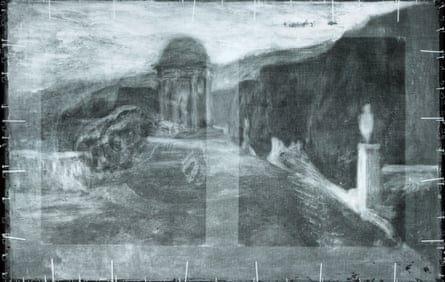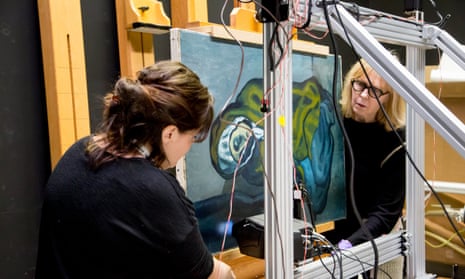Wrapped in a mustard coloured blanket with a white scarf and her head on one side, Pablo Picasso’s La Misereuse Accroupie (The Crouching Beggar) is a study of forlorn resignation. But researchers say that there is more to desolate character than meets the eye.
Beneath the mournful image lies another painting, a landscape, researchers have revealed after using non-invasive imaging techniques to examine the work.
The study has also shed light on previously hidden features of Picasso’s early attempts at his desolate figure.
“This is where technology allows us to get into the mind of the artist, so we can actually understand the creative process of Picasso and how he actually started producing this work of art,” said Marc Walton of Northwestern University, who is presenting the work at the meeting of the American Association for the Advancement of Science in Texas.
La Misereuse Accroupie was painted by Picasso in 1902, during Picasso’s early “blue period”. It currently hangs in the the Art Gallery of Ontario, Canada.
The first secrets of the painting were discovered by conservators in 1992. Eagle-eyed experts had noticed that the surface texture of parts of Picasso’s painting seemed at odds with the brush strokes of the figure. “There is also unrelated colour peeking through the cracklines that always suggests either a change in composition or a reused canvas,” added Sandra Webster-Cook, senior conservator of paintings at the Art Gallery of Ontario.

When an x-ray image, known as an x-radiograph, of the painting was taken as part of background research, the team found the hidden landscape scene.
To probe further, the gallery team joined forces with researchers from Northwestern University. By using a technique known as x-ray fluorescence, researchers looked across the canvas at the distribution of chemical elements that are found in different pigments.
“This gives us a little bit better sensibility about how this layered structure has developed, because some pigments are only in one layer and not another,” said Walton. Tiny fragments taken from the painting were also analysed to further probe the layers.
Information from x-radiographs, backed up by findings from the x-ray fluorescence, revealed that Picasso adopted shapes that had been laid out in the landscape.
“[Picasso] used the landscape as inspiration for the shape of the woman,” said Walton. “The hills that were painted in the background become the contours of her back.”
But just who the landscape painting is by remains a mystery. Initial suggestions that it was a work by the artist Joaquín Torres-García have been dismissed now that curators believe the landscape depicts a real location in Barcelona, the Parc del Laberint d’Horta. “We know that Santiago Rusiñol, the leader of the Catalan modernisme movement, painted this site, and we believe other younger Catalan painters would have painted this site too,” said Kenneth Brummel, assistant curator of modern art at the Art Gallery of Ontario.
The x-ray fluorescence also uncovered another surprise. While the distribution of iron and chromium pigments matched well with the figure of the woman as seen today, the spread of cadmium and lead based pigments provided insights into the puzzling surface features.
The distribution of these pigments showed slight differences in the tilt of the woman’s head and revealed that she originally had a right arm and hand, possibly holding a piece of bread.
With a watercolour by Picasso of a crouching woman with a similar arrangement of hands also holding a circular piece of bread recently sold at auction, the team suggest the two works might be linked. But that has raised questions about why, in the final painting, the bread-bearing hand is absent. “Is it something that is religious but he then decides to paint over it because he doesn’t want that connotation in this particular painting?” suggested Walton.
Walton adds that the ultimate goal is to identify the colours of the original landscape. “This is really the holy grail because then we [have] uncovered this lost painting and it is part of the world again,” he said.
The latest discovery is not the first time a work of art has been found lurking beneath a Picasso: conservators have previously revealed a portrait of a man wearing a bow-tie beneath a painting known as The Blue Room, while a moustachioed, cravat-wearing man has been found hidden underneath the painting Woman Ironing. In both cases the concealed portraits are thought to be by Picasso himself.
“The interesting thing about the blue period is that Picasso was reusing materials because he probably didn’t have a lot of money at this early period in his life,” said Walton.
Dr Nicola Ashmore from the University of Brighton, who has been researching Picasso’s Guernica, welcomed the revelations.
“This new discovery presents some fascinating findings with regards to Picasso’s painting practices of working on used canvases – finding inspiration from the forms and composition of the paintings worked into the canvas that lie beneath La Misereuse,” she said. “The application of new technologies within art history is contributing to the formation of an archaeology for each painting it is applied to.”
